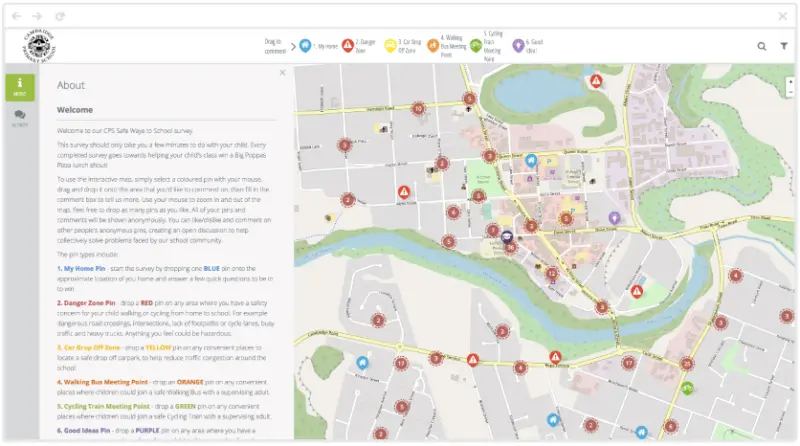Location: Cambridge, New Zealand
Goal: The goal of this project was to help school officials understand the barriers and safety concerns parents have around their children cycling and walking to and from school safely. With the guidance of CCASM, Cambridge Primary School hoped to gather information from families who were directly affected by these safety concerns in order to create a plan for safer ways for children to get to school. 80% of kids normally get dropped off by car and Cambridge Primary School wants this to change.
“The major impact that I’m hoping this is going to have on our school is that parents to see is that this is not a real traffic congestion problem around Cambridge Primary School but a how children get to school problem” – Mike Pettit – Cambridge Primary School, Principal
Background
The number of children walking and biking to school is drastically declining across New Zealand with 80% of kids normally dropped off by car and Cambridge Primary School wants this to change. Although the reasons for the decrease are complex, research shows that children walking and biking to school is great for kid’s growth in independence, mobility, fitness, health, and education.
Car drop off zones and school gates have become congested with traffic, making it a dangerous place for children. Cambridge Primary School (CPS) in New Zealand was chosen to participate in the Safe Ways to School pilot survey run by CCASM and supported by other key stakeholders. This survey came at a perfect time as CPS had plans in full swing for the construction of a scooter and bike track shortly after.
Challenges
The survey focused on gathering information from students and their parents about safety concerns around their children getting to and from school. The school had a plan in full swing before the start of this survey for the construction of a scooter and bike track which received concerns from parents about the safety of this track. CPS realized that in order to create this plan to suit the needs of their community, they would need to consult those who have concerns in order to address them correctly and create better routes to school for the future. To encourage more families to participate in their online survey, they offered a pizza lunch shout to the class with the most participants.
Implementing Social Pinpoint
The CPS bike and scooter path will assist with teaching children bike handling skills, but doesn’t give them an option to get to and from school on it unfortunately. The school is doing more in this area to get supervised walking school buses and cycling trains up and going. CCASM has provided them with an alternative parking map for parents to park and walk safely to school (avoiding school gates at peak times).
CCASM used Social Pinpoint to host an online interactive map where CPS would hold their survey. The school recognized that many families don’t have a lot of extra time in a day to sit down and participate in a survey so they made it as easy as possible. With an online engagement strategy, families could access the survey from virtually anywhere. The goal of this survey was to make it as easy as possible to access and engage in order to gain the most participants possible.
CCASM worked with CPS to create the video below to explain how to use the website.
“The ability to look around the map and recognize points I thought could be improved was a good way to do it, rather than marking a box on a form.” -Nathan Twaddle (parent)
They also included these straight forward instructions to explain how to drop pins and thoroughly explained the different types of pins included in the survey.

Key Findings & Closing the Loop
CPS received responses from 138 parents or 43% of families. “Responses were real positive. Plenty of people engaged. It really brought out the challenges that parents had. They gave really in depth answers. They want their children to walk and cycle to school but they want it done safely. And thats really what came out of the survey. We found out the concerns of parents and areas of potential danger. We also found some great drop off points that parents felt were safe” said Mike.
They found that parents and students were grateful that the school was interested in their concerns and wanted to give their input in hopes for changes in the future. By gathering information on ‘danger zones’ they were able to identify hot spots where parents worried about their children getting to school safely. Many participants mentioned speed control, speed bumps, and pedestrian crossings. Parents were able to suggest safe drop off zones, walking bus meeting points, cycling train meeting points, and general ideas which the school will take into consideration when making plans for updates. Cambridge Primary School hopes that their new scooter and bike path will resolve some issues and give children a safer and healthier option to get to school.












